High efficiency fluorescent compound and method for preparing the same
Kim , et al. September 29, 2
U.S. patent number 10,787,607 [Application Number 14/344,585] was granted by the patent office on 2020-09-29 for high efficiency fluorescent compound and method for preparing the same. This patent grant is currently assigned to SNU R&DB FOUNDATION. The grantee listed for this patent is Jun Hee Kang, Eun Ha Kim, Seong Keun Kim, Seung Bum Park, Il Seung Yang, II. Invention is credited to Jun Hee Kang, Eun Ha Kim, Seong Keun Kim, Seung Bum Park, Il Seung Yang, II.
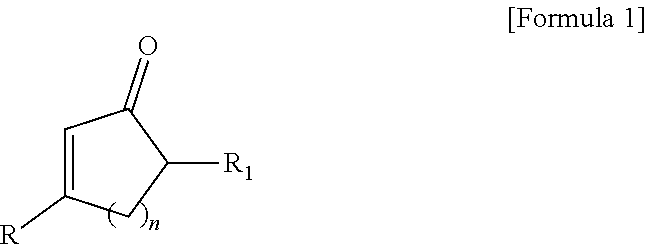
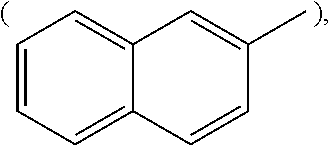


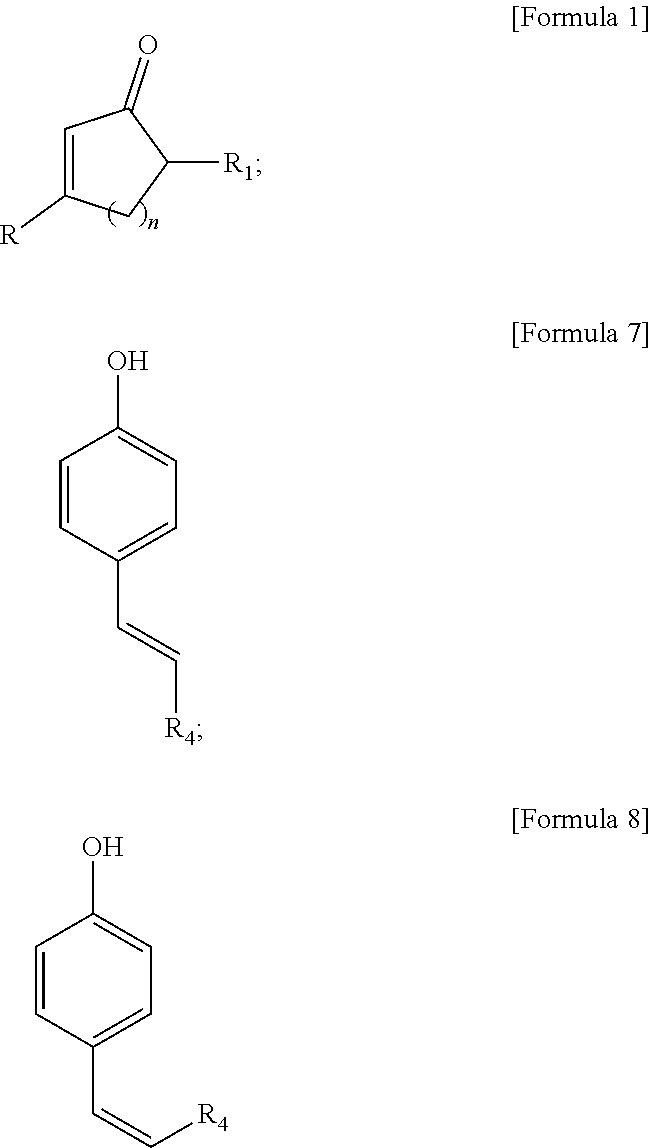
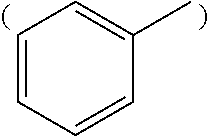
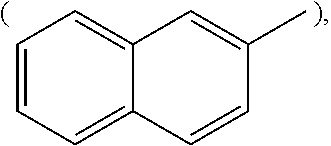
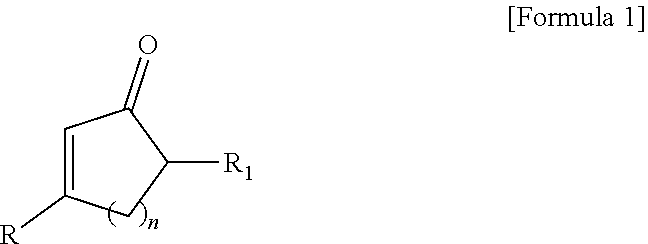
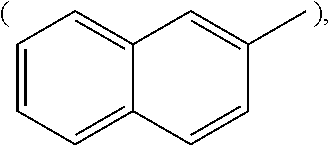

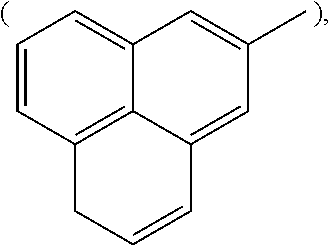
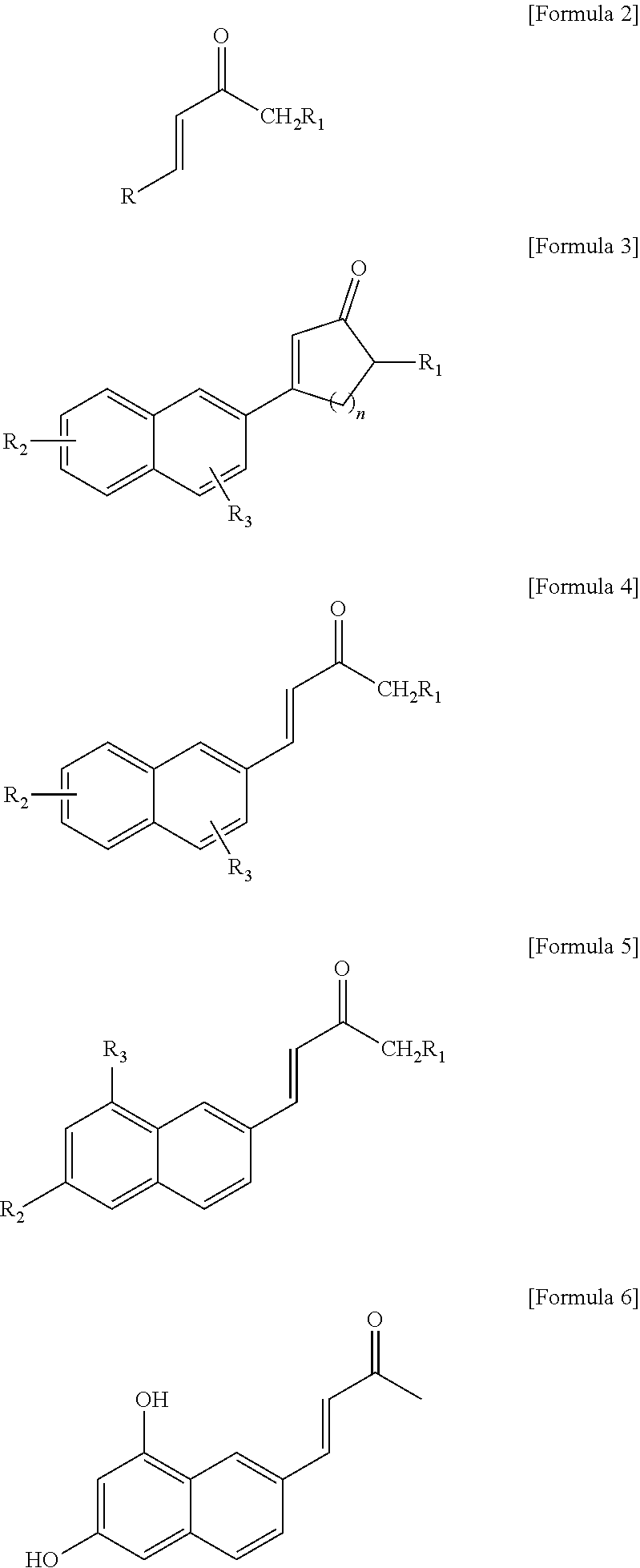
View All Diagrams
| United States Patent | 10,787,607 |
| Kim , et al. | September 29, 2020 |
High efficiency fluorescent compound and method for preparing the same
Abstract
The present invention provides a fluorescent resveratrone [(E)-4-(6,8-dihydroxynaphthalen-2-yl)but-3-en-2-one] and its derivatives having Formula 1 and a method for preparing the same by a photochemical reaction of resveratrol and its derivatives which are not fluorescent having Formula 7 or Formula 8. The new fluorescent compounds of the present invention has single-photon absorptive characteristics and/or two-photon absorptive characteristics as well as no or little toxicity according to a cytotoxicity test and can be usefully utilized in the field of organic fluorescent element, display element, spectrometer, two-photon absorptive storing device, laser micro processing apparatus, photo dynamic therapy apparatus and the like.
| Inventors: | Kim; Seong Keun (Seoul, KR), Park; Seung Bum (Seoul, KR), Yang, II; Il Seung (Seoul, KR), Kim; Eun Ha (Seoul, KR), Kang; Jun Hee (Seoul, KR) | ||||||||||
|---|---|---|---|---|---|---|---|---|---|---|---|
| Applicant: |
|
||||||||||
| Assignee: | SNU R&DB FOUNDATION (Seoul,
KR) |
||||||||||
| Family ID: | 48179887 | ||||||||||
| Appl. No.: | 14/344,585 | ||||||||||
| Filed: | September 5, 2012 | ||||||||||
| PCT Filed: | September 05, 2012 | ||||||||||
| PCT No.: | PCT/KR2012/007133 | ||||||||||
| 371(c)(1),(2),(4) Date: | June 11, 2015 | ||||||||||
| PCT Pub. No.: | WO2013/039307 | ||||||||||
| PCT Pub. Date: | March 21, 2013 |
Prior Publication Data
| Document Identifier | Publication Date | |
|---|---|---|
| US 20190330524 A1 | Oct 31, 2019 | |
Foreign Application Priority Data
| Sep 16, 2011 [KR] | 10-2011-0093191 | |||
| Jul 30, 2012 [KR] | 10-2012-0083374 | |||
| Current U.S. Class: | 1/1 |
| Current CPC Class: | A61K 49/0021 (20130101); A61K 49/0054 (20130101); H01L 51/5012 (20130101); A61K 49/0052 (20130101); C07C 49/248 (20130101); C09K 11/06 (20130101); A61N 5/062 (20130101); C07C 49/255 (20130101); H01L 51/0052 (20130101); C07H 15/203 (20130101); C09K 2211/1011 (20130101) |
| Current International Class: | C07C 49/00 (20060101); H01L 51/00 (20060101); C09K 11/06 (20060101); H01L 51/50 (20060101); C07C 49/255 (20060101); C07H 15/203 (20060101); A61K 49/00 (20060101); A61N 5/06 (20060101); C09K 11/00 (20060101); C07C 49/248 (20060101) |
References Cited [Referenced By]
U.S. Patent Documents
| 2010/0081724 | April 2010 | Souto |
| 2015/0031867 | January 2015 | Kim et al. |
| 10-2009-0041632 | Apr 2009 | KR | |||
| 10-2013-0030326 | Mar 2013 | KR | |||
| 10-1244176 | Mar 2013 | KR | |||
| 10-1294993 | Aug 2013 | KR | |||
| 2009/054608 | Apr 2009 | WO | |||
| 2013/039307 | Mar 2013 | WO | |||
| 2013039308 | Mar 2013 | WO | |||
Other References
|
Yang, et al., "Photochemical Generation of a New, Highly Fluorescent Compound from Non-Fluorescent Resveratrol", Chemical Communications, (Feb. 24, 2012) pp. 3839-3841. cited by applicant . International Search Report--PCT/US2012/007137--ISA/KR--dated Feb. 28, 2013 (dated Feb. 28, 2013). cited by applicant . Written Opinion--PCT/US2012/007137--ISA/KR--dated Feb. 28, 2013 (dated Feb. 28, 2013). cited by applicant . Kim, H. M. et al. "Two-Photon Fluorescent Turn-On Probe for Lipid Rafts in Live Cell and Tissue" Journal of the American Chemical Society (2008), 130(13), 4246-4247. cited by applicant . Lemhadri, M. et al. "Palladium-Catalyzed Heck Reasctions of alk-1-en-3-ones with Aryl Bromides: A Very Simple Access to (E)-1-arylalk-1-en-3-one", Synthesis 2009. pp. 1021-1035, 15 Pages. cited by applicant . Written Opinion issued by the International Searching Authority for PCT/KR2012/007133 dated Feb. 28, 2013. 5 pages. cited by applicant . Search Report issued by the International Searching Authority for PCT/KR2012/007133 dated Feb. 28, 2013. 3 pages. cited by applicant . Korean Office Action, Issued by the Korean Intellectual Property Office, dated Mar. 19, 2013, for Korean Application No. 2012-0083374. 4 Pages. cited by applicant. |
Primary Examiner: Witherspoon; Sikarl A
Attorney, Agent or Firm: Brundidge & Stanger, P.C.
Claims
The invention claimed is:
1. A fluorescent compound represented by the following formula 2: ##STR00023## wherein R is naphthyl group ##STR00024## anthracenyl group ##STR00025## or phenalenyl group ##STR00026## wherein said naphthyl, anthracenyl or phenalenyl group are each independently substituted with at least two substituents selected from the group consisting of hydroxy; halogen; straight-chain or branched C.sub.1-C.sub.10 alkyl; C.sub.3-C.sub.6 cycloalkyl; straight-chain or branched C.sub.1-C.sub.6 alkoxy; C.sub.2-C.sub.6 heterocycloalkyl comprising N, O and/or S as heteroatom; phenyl group which is unsubstituted or substituted with at least one substituent selected from the group consisting of halogen atom, amino group, nitrile group, nitro group, C.sub.1-C.sub.10 alkyl group, C.sub.2-C.sub.10 alkenyl group, C.sub.1-C.sub.10 alkoxy group, C.sub.3-C.sub.6 cyclaoalkyl group, C.sub.2-C.sub.6 heterocycloalkyl group comprising N, O or S as heteroatom, C.sub.6-C.sub.16 aryl group, and C.sub.5-C.sub.15 heteroaryl group comprising N, O and/or S as heteroatom; benzyl group which is unsubstituted or substituted with at least one substituent selected from the group consisting of halogen atom, amino group, nitrile group, nitro group, C.sub.1-C.sub.10 alkyl group, C.sub.2-C.sub.10 alkenyl group, C.sub.1-C.sub.10 alkoxy group, C.sub.3-C.sub.6 cyclaoalkyl group, C.sub.2-C.sub.6 heterocycloalkyl group comprising N, O and/or S as heteroatom, C.sub.6-C.sub.30 aryl group and C.sub.5-C.sub.30 heteroaryl group comprising N, O and/or S as heteroatom; benzoyl; C.sub.1-C.sub.10 alkylamino; di(C.sub.1-C.sub.10 alkyl)amino; and C.sub.1-C.sub.10 alkoxy; and wherein R.sub.1 is selected from the group consisting of hydrogen atom; halogen, straight-chain or branched C.sub.1-C.sub.6 alkyl, C.sub.3-C.sub.6 cycloalkyl, straight-chain or branched C.sub.1-C.sub.6 alkoxy; C.sub.2-C.sub.6 heterocycloalkyl comprising N, O and/or S as heteroatom; and phenyl group which is unsubstituted or substituted with at least one substituent selected from the group consisting of halogen atom, amino group, nitrile group, nitro group, C.sub.1-C.sub.10 alkyl group, C.sub.2-C.sub.10 alkenyl group, C.sub.1-C.sub.10 alkoxy group, C.sub.3-C.sub.6 cyclaoalkyl group, C.sub.2-C.sub.6 heterocycloalkyl group comprising N, O or S as heteroatom, C.sub.6-C.sub.16 aryl group, and C.sub.5-C.sub.15 heteroaryl group comprising N, O and/or S as heteroatom.
2. The fluorescent compound according to claim 1, wherein the compound is represented by the following formula 4: ##STR00027## wherein R.sub.1is the same as defined in claim 1, and wherein R.sub.2 and R.sub.3 are each independently selected from a group consisting of hydrogen atom; hydroxy; halogen; straight-chain or branched C.sub.1-C.sub.10 alkyl; C.sub.3-C.sub.6 cycloalkyl; straight-chain or branched C.sub.1-C.sub.6 alkoxy; C.sub.2-C.sub.6 heterocycloalkyl comprising N, O and/or S as heteroatom; phenyl group which is unsubstituted or substituted with at least one substituent selected from the group consisting of halogen atom, amino group, nitrile group, nitro group, C.sub.1-C.sub.10 alkyl group, C.sub.2-C.sub.10 alkenyl group, C.sub.1-C.sub.10 alkoxy group, C.sub.3-C.sub.6 cyclaoalkyl group, C.sub.2-C.sub.6 heterocycloalkyl group comprising N, O or S as heteroatom, C.sub.6-C.sub.16 aryl group, and C.sub.5-C.sub.15 heteroaryl group comprising N, O and/or S as heteroatom; benzyl group which is unsubstituted or substituted with at least one substituent selected from the group consisting of halogen atom, amino group, nitrile group, nitro group, C.sub.1-C.sub.10 alkyl group, C.sub.2-C.sub.10 alkenyl group, C.sub.1-C.sub.10 alkoxy group, C.sub.3-C.sub.6 cyclaoalkyl group, C.sub.2-C.sub.6 heterocycloalkyl group comprising N, O and/or S as heteroatom, C.sub.6-C.sub.30 aryl group and C.sub.5-C.sub.30 heteroaryl group comprising N, O and/or S as heteroatom; benzoyl; C.sub.1-C.sub.10 alkylamino; di(C.sub.1-C.sub.10 alkyl)amino; and C.sub.1-C.sub.10 alkoxy.
3. The fluorescent compound according to claim 2, wherein the compound is represented by the following formula 5: ##STR00028## wherein, R.sub.1, R.sub.2 and R.sub.3 are the same as defined in claim 2.
4. The fluorescent compound according to claim 3, wherein the compound is represented by the following formula 6: ##STR00029##
5. A method of preparing a fluorescent compound represented by the following Formula 1, the method comprising dissolving a compound represented by Formula 7, a compound represented by Formula 8 or a mixture thereof in water or an organic solvent, and subjecting to an UV irradiation: ##STR00030## wherein, R.sub.1 and n are the same as defined in claim 1, and R.sub.4 is substituted or unsubstituted phenyl group ##STR00031## or substituted or unsubstituted naphthyl group ##STR00032## wherein, said phenyl or naphthyl group can be each independently substituted with at least one substituent selected from the group consisting of hydroxy; halogen; straight-chain or branched C.sub.1-C.sub.10 alkyl; C.sub.3-C.sub.6 cycloalkyl; straight-chain or branched C.sub.1-C.sub.6 alkoxy; C.sub.2-C.sub.6 heterocycloalkyl comprising N, O and/or S as heteroatom; phenyl group which is unsubstituted or substituted with at least one substituent selected from the group consisting of halogen atom, amino group, nitrile group, nitro group, C.sub.1-C.sub.10 alkyl group, C.sub.2-C.sub.10 alkenyl group, C.sub.1-C.sub.10 alkoxy group, C.sub.3-C.sub.6 cyclaoalkyl group, C.sub.2-C.sub.6 heterocycloalkyl group comprising N, O or S as heteroatom, C.sub.6-C.sub.16 aryl group, and C.sub.5-C.sub.15 heteroaryl group comprising N, O and/or S as heteroatom; benzyl group which is unsubstituted or substituted with at least one substituent selected from the group consisting of halogen atom, amino group, nitrile group, nitro group, C.sub.1-C.sub.10 alkyl group, C.sub.2-C.sub.10 alkenyl group, C.sub.1-C.sub.10 alkoxy group, C.sub.3-C.sub.6 cyclaoalkyl group, C.sub.2-C.sub.6 heterocycloalkyl group comprising N, O and/or S as heteroatom, C.sub.6-C.sub.30 aryl group and C.sub.5-C.sub.30 heteroaryl group comprising N, O and/or S as heteroatom; benzoyl; C.sub.1-C.sub.10 alkylamino; di(C.sub.1-C.sub.10 alkyl)amino; and C.sub.1-C.sub.10 alkoxy.
6. The method according to claim 5, further comprising adding ascorbic acid, polyphenol or a mixture thereof after dissolving a compound represented by Formula 7, a compound represented by Formula 8 or a mixture thereof in water or an organic solvent, and before subjecting to an UV irradiation.
7. The method according to claim 5, wherein the method is conducted under N.sub.2 atmosphere or N.sub.2 purging.
8. An organic fluorescent element comprising fluorescent compounds according to claim 1.
9. A display element comprising organic fluorescent elements according to claim 8.
10. A spectrometer, a two-photon absorptive storing device, a laser micro processing apparatus, or a photo dynamic therapy apparatus, comprising the organic fluorescent elements according to claim 8.
11. An organic fluorescent element comprising fluorescent compounds according to claim 2.
12. An organic fluorescent element comprising fluorescent compounds according to claim 3.
13. An organic fluorescent element comprising fluorescent compounds according to claim 4.
Description
TECHNICAL FIELD
The present invention relates to a new fluorescent compound having high efficiency, a method for preparing the same, and its use.
BACKGROUND ART
There are cases where light is emitted from a substance at a low temperature at which the substance can not emit any visible ray by thermal radiation. Such lighting phenomenon is referred to as luminescence. Luminescence means the emission of light having a wavelength which correspond to the energy difference when a substance is converted to a stable state having low energy from an unstable state having high energy. Thus, in order to make a substance emit such light, it is necessary to make the substance to an unstable excited state having high energy. Various sources of energy such as light, chemical reactions, heat, electricity, cathode-emitted electron or the like may be used. Said difference sources of energy produce different types of light emission such as photo-, chemi-, thermo-, electro-, cathodo-luminecence, or the like.
Luminescence can be classified as fluorescence and phosphorescence. Fluorescence refers to the phenomenon that a substance emits light only when the substance is irradiated, and phosphorescence refers to the phenomenon that a substance continuously emits a light even after the irradiation to the substance is ended.
In this regard, a substance emitting fluorescence is referred to as a fluorescent element or a fluorescent substance. Such fluorescent substance can be divided into a single-photon absorption fluorescent substance which absorbs only one photon under a strong laser to emit the fluorescence and a multi-photon absorption fluorescent substance which absorbs a plurality of photons to emit the fluorescence. The present invention relates to a new fluorescent compound simultaneously having a single-photon absorption fluorescent feature as well as a multi-photon absorption fluorescent feature, in particular, 2-photon absorption fluorescent feature.
In more particular, the present invention was completed by finding a new fluorescent compound of (E)-4-(6,8-dihydroxynaphthalen-2-yl)but-3-en-2-one (hereinafter, referred to as resveratrone) having a high single-photon absorptive efficiency and/or 2-photon absorptive efficiency after a photochemical reaction of a conventionally known resveratrol which is frequently found in peanuts, grapes, berries and the like.
DISCLOSURE OF INVENTION
Technical Problem
The purpose of the present invention is to provide a new fluorescent compound with high efficiency having single-photon absorptive characteristics and/or two-photon absorptive characteristics.
Also, the purpose of the present invention is to provide a method of preparing the above fluorescent compound.
In addition, the purpose of the present invention is to provide the use of the fluorescent compound having single-photon absorptive characteristics and/or two-photon absorptive characteristics.
Solution to Problem
In order to achieve the above purposes, the present invention provides resveratrone [(E)-4-(6,8-dihydroxynaphthalen-2-yl)but-3-en-2-one] and its derivatives as a new fluorescent compound and a method for preparing the same by a photochemical reaction of resveratrol and its derivatives which are not fluorescent.
(1) A fluorescent compound represented by the following formula 1:
##STR00001##
[wherein, R is naphthyl group
##STR00002## anthracenyl group
##STR00003## or phenalenyl group,
##STR00004##
wherein said naphthyl, anthracenyl or phenalenyl group can be each independently substituted with at least one substituent selected from the group consisting of hydroxy; halogen; straight-chain or branched C.sub.1-C.sub.10 alkyl; C.sub.3-C.sub.6 cycloalkyl; straight-chain or branched C.sub.1-C.sub.6 alkoxy; C.sub.2-C.sub.6 heterocycloalkyl comprising N, O and/or S as heteroatom; phenyl group which is unsubstituted or substituted with at least one substituent selected from the group consisting of halogen atom, amino group, nitrile group, nitro group, C.sub.1-C.sub.10 alkyl group, C.sub.2-C.sub.10 alkenyl group, C.sub.1-C.sub.10 alkoxy group, C.sub.3-C.sub.6 cyclaoalkyl group, C.sub.2-C.sub.6 heterocycloalkyl group comprising N, O or S as heteroatom, C.sub.6-C.sub.16 aryl group, and C.sub.5-C.sub.15 heteroaryl group comprising N, O and/or S as heteroatom; benzyl group which is unsubstituted or substituted with at least one substituent selected from the group consisting of halogen atom, amino group, nitrile group, nitro group, C.sub.1-C.sub.10 alkyl group, C.sub.2-C.sub.10 alkenyl group, C.sub.1-C.sub.10 alkoxy group, C.sub.3-C.sub.6 cyclaoalkyl group, C.sub.2-C.sub.6 heterocycloalkyl group comprising N, O and/or S as heteroatom, C.sub.6-C.sub.30 aryl group and C.sub.5-C.sub.30 heteroaryl group comprising N, O and/or S as heteroatom; benzoyl; C.sub.1-C.sub.10 alkylamino; di(C.sub.1-C.sub.10 alkyl)amino; and C.sub.1-C.sub.10 alkoxy;
each of R.sub.1 is independently hydrogen atom; halogen, straight-chain or branched C.sub.1-C.sub.6 alkyl, C.sub.3-C.sub.6 cycloalkyl, straight-chain or branched C.sub.1-C.sub.6 alkoxy; C.sub.2-C.sub.6 heterocycloalkyl comprising N, O and/or S as heteroatom; phenyl group which is unsubstituted or substituted with at least one substituent selected from the group consisting of halogen atom, amino group, nitrile group, nitro group, C.sub.1-C.sub.10 alkyl group, C.sub.2-C.sub.10 alkenyl group, C.sub.1-C.sub.10 alkoxy group, C.sub.3-C.sub.6 cyclaoalkyl group, C.sub.2-C.sub.6 heterocycloalkyl group comprising N, O or S as heteroatom, C.sub.6-C.sub.16 aryl group, and C.sub.5-C.sub.15 heteroaryl group comprising N, O and/or S as heteroatom;
n is 0, 1, 2 or 3 (wherein, n=0 means that the carbon ring is open)].
(2) A method of preparing a fluorescent compound represented by the following Formula 1, characterized in that it comprises a step of dissolving a compound represented by Formula 7, a compound represented by Formula 8 or a mixture thereof in water or an organic solvent, and a step of subjecting to an UV irradiation:
##STR00005##
[wherein, R.sub.1 and n are the same as defined in above (1),
R.sub.4 is substituted or unsubstituted phenyl group
##STR00006## or substituted or unsubstituted naphthyl group
##STR00007##
wherein, said phenyl or naphthyl group can be each independently substituted with at least one substituent selected from the group consisting of hydroxy; halogen; straight-chain or branched C.sub.1-C.sub.10 alkyl; C.sub.3-C.sub.6 cycloalkyl; straight-chain or branched C.sub.1-C.sub.6 alkoxy; C.sub.2-C.sub.6 heterocycloalkyl comprising N, O and/or S as heteroatom; phenyl group which is unsubstituted or substituted with at least one substituent selected from the group consisting of halogen atom, amino group, nitrile group, nitro group, C.sub.1-C.sub.10 alkyl group, C.sub.2-C.sub.10 alkenyl group, C.sub.1-C.sub.10 alkoxy group, C.sub.3-C.sub.6 cyclaoalkyl group, C.sub.2-C.sub.6 heterocycloalkyl group comprising N, O or S as heteroatom, C.sub.6-C.sub.16 aryl group, and C.sub.5-C.sub.15 heteroaryl group comprising N, O and/or S as heteroatom; benzyl group which is unsubstituted or substituted with at least one substituent selected from the group consisting of halogen atom, amino group, nitrile group, nitro group, C.sub.1-C.sub.10 alkyl group, C.sub.2-C.sub.10 alkenyl group, C.sub.1-C.sub.10 alkoxy group, C.sub.3-C.sub.6 cyclaoalkyl group, C.sub.2-C.sub.6 heterocycloalkyl group comprising N, O and/or S as heteroatom, C.sub.6-C.sub.30 aryl group and C.sub.5-C.sub.30 heteroaryl group comprising N, O and/or S as heteroatom; benzoyl; C.sub.1-C.sub.10 alkylamino; di(C.sub.1-C.sub.10 alkyl)amino; and C.sub.1-C.sub.10 alkoxy].
(3) An organic fluorescent element comprising the fluorescent compound of (1).
(4) A display element comprising the organic fluorescent compound of (3).
(5) A spectrometer, a two-photon absorptive storing device, a laser micro processing apparatus, or a photo dynamic therapy apparatus, comprising the organic fluorescent element of (3).
Advantageous Effects of Invention
The new fluorescent compound of the present invention has single-photon absorptive characteristics and/or two-photon absorptive characteristics as well as no or little toxicity according to a cytotoxicity test.
BRIEF DESCRIPTION OF DRAWINGS
FIG. 1 is a graph showing emission spectra of the reactant compounds and the fluorescent compound finally produced of the present invention (wherein the highly fluorescent species is denoted by X).
FIG. 2 is a graph showing a single-photon emission spectrum (left) and a two-photon emission spectrum (right) of the fluorescent compound of the present invention.
FIG. 3 is graph showing a change of single-photon emission spectra of the fluorescent compound finally of the present invention.
FIG. 4 is a photograph showing two-photon emission of the fluorescent compound of the present invention.
FIG. 5 is a HPLC graph for the reaction products obtained after different durations of exposure to UV irradiation (wherein the highly fluorescent species is denoted by X).
FIG. 6 is a graph showing the comparison of the intensity versus wavelength of the fluorescent compounds which have been produced in the presence of ascorbic acid and in the absence of ascorbic acid, respectively.
FIG. 7 is a graph showing the comparison of the intensity versus wavelength of the fluorescent compounds which have been produced under N.sub.2 atmosphere (N.sub.2 purging) and not, respectively.
FIG. 8 is a graph showing an excitation spectrum of the reactant compound and an emission spectrum of the fluorescent compound finally produced in Example 10 of the present invention.
FIG. 9 is a graph showing an excitation spectrum of the reactant compound and an emission spectrum of the fluorescent compound finally produced in Example 11 of the present invention.
FIG. 10 is a graph showing an excitation spectrum of the reactant compound and an emission spectrum of the fluorescent compound finally produced in Example 12 of the present invention.
FIG. 11 is a graph showing an excitation spectrum of the reactant compound and an emission spectrum of the fluorescent compound finally produced in Example 13 of the present invention.
FIG. 12 is the photo images showing the result of Cytomorphology Test for a blank test (Control), a fluorescent compound of the present invention (Resveratrone) and a comparative compound (a commercial anticancer agent, Etoposide).
FIG. 13 is a graph showing the result of Blue Exclusion Test for a blank test (Control), a fluorescent compound of the present invention (Resveratrone) and a comparative compound (Etoposide).
FIG. 14 is a graph showing the result of Western Blotting Test for a blank test (Control), a fluorescent compound of the present invention (Resveratrone) and a comparative compound (Etoposide).
BEST MODE FOR CARRYING OUT THE INVENTION
Hereinafter, the present invention will be explained in more detail in the term of construction and effect.
The present invention provides a new fluorescent compound represented by the following formula 1:
##STR00008##
[Wherein, R is naphthyl group
##STR00009## anthracenyl group
##STR00010## or phenalenyl group
##STR00011##
wherein said naphthyl, anthracenyl or phenalenyl group can be each independently substituted with at least one substituent selected from the group consisting of hydroxy; halogen; straight-chain or branched C.sub.1-C.sub.10 alkyl; C.sub.3-C.sub.6 cycloalkyl; straight-chain or branched C.sub.1-C.sub.6 alkoxy; C.sub.2-C.sub.6 heterocycloalkyl comprising N, O and/or S as heteroatom; phenyl group which is unsubstituted or substituted with at least one substituent selected from the group consisting of halogen atom, amino group, nitrile group, nitro group, C.sub.1-C.sub.10 alkyl group, C.sub.2-C.sub.10 alkenyl group, C.sub.1-C.sub.10 alkoxy group, C.sub.3-C.sub.6 cyclaoalkyl group, C.sub.2-C.sub.6 heterocycloalkyl group comprising N, O or S as heteroatom, C.sub.6-C.sub.16 aryl group, and C.sub.5-C.sub.15 heteroaryl group comprising N, O and/or S as heteroatom; benzyl group which is unsubstituted or substituted with at least one substituent selected from the group consisting of halogen atom, amino group, nitrile group, nitro group, C.sub.1-C.sub.10 alkyl group, C.sub.2-C.sub.10 alkenyl group, C.sub.1-C.sub.10 alkoxy group, C.sub.3-C.sub.6 cyclaoalkyl group, C.sub.2-C.sub.6 heterocycloalkyl group comprising N, O and/or S as heteroatom, C.sub.6-C.sub.30 aryl group and C.sub.5-C.sub.30 heteroaryl group comprising N, O and/or S as heteroatom; benzoyl; C.sub.1-C.sub.10 alkylamino; di(C.sub.1-C.sub.10 alkyl)amino; and C.sub.1-C.sub.10 alkoxy; preferably, independently substituted with hydroxyl, halogen, straight-chain or branched C.sub.1-C.sub.10 alkyl, C.sub.3-C.sub.6 cycloalkyl, straight-chain or branched C.sub.1-C.sub.6 alkoxy or C.sub.2-C.sub.6 heterocycloalkyl comprising N, O and/or S as heteroatom; more preferably, independently substituted with hydroxyl, halogen or straight-chain or branched C.sub.1-C.sub.10 alkyl;
each of R.sub.1 is independently hydrogen atom; halogen, straight-chain or branched C.sub.1-C.sub.6 alkyl, C.sub.3-C.sub.6 cycloalkyl, straight-chain or branched C.sub.1-C.sub.6 alkoxy; C.sub.2-C.sub.6 heterocycloalkyl comprising N, O and/or S as heteroatom; phenyl group which is unsubstituted or substituted with at least one substituent selected from the group consisting of halogen atom, amino group, nitrile group, nitro group, C.sub.1-C.sub.10 alkyl group, C.sub.2-C.sub.10 alkenyl group, C.sub.1-C.sub.10 alkoxy group, C.sub.3-C.sub.6 cyclaoalkyl group, C.sub.2-C.sub.6 heterocycloalkyl group comprising N, O or S as heteroatom, C.sub.6-C.sub.16 aryl group, and C.sub.5-C.sub.15 heteroaryl group comprising N, O and/or S as heteroatom; preferably, selected from the group consisting of hydrogen atom, hydroxyl, halogen, straight-chain or branched C.sub.1-C.sub.10 alkyl, C.sub.3-C.sub.6 cycloalkyl, straight-chain or branched C.sub.1-C.sub.6 alkoxy or C.sub.2-C.sub.6 heterocycloalkyl comprising N, O and/or S as heteroatom; more preferably, selected from the group consisting of hydrogen atom, hydroxyl, halogen or straight-chain or branched C.sub.1-C.sub.10 alkyl;
n is 0, 1, 2 or 3, preferably 0 or 1, more preferably 0 (wherein, n=0 means that the carbon ring is open)].
Also, the present invention provides a fluorescent compound represented by any one of the following formulae 2.about.6:
##STR00012##
[wherein, R, R.sub.1 and n are the same as defined in the above, and
R.sub.2 and R.sub.3 are each independently selected from a group consisting of hydrogen atom; hydroxy; halogen; straight-chain or branched C.sub.1-C.sub.10 alkyl; C.sub.3-C.sub.6 cycloalkyl; straight-chain or branched C.sub.1-C.sub.6 alkoxy; C.sub.2-C.sub.6 heterocycloalkyl comprising N, O and/or S as heteroatom; phenyl group which is unsubstituted or substituted with at least one substituent selected from the group consisting of halogen atom, amino group, nitrile group, nitro group, C.sub.1-C.sub.10 alkyl group, C.sub.2-C.sub.10 alkenyl group, C.sub.1-C.sub.10 alkoxy group, C.sub.3-C.sub.6 cyclaoalkyl group, C.sub.2-C.sub.6 heterocycloalkyl group comprising N, O or S as heteroatom, C.sub.6-C.sub.16 aryl group, and C.sub.5-C.sub.15 heteroaryl group comprising N, O and/or S as heteroatom; benzyl group which is unsubstituted or substituted with at least one substituent selected from the group consisting of halogen atom, amino group, nitrile group, nitro group, C.sub.1-C.sub.10 alkyl group, C.sub.2-C.sub.10 alkenyl group, C.sub.1-C.sub.10 alkoxy group, C.sub.3-C.sub.6 cyclaoalkyl group, C.sub.2-C.sub.6 heterocycloalkyl group comprising N, O and/or S as heteroatom, C.sub.6-C.sub.30 aryl group and C.sub.5-C.sub.30 heteroaryl group comprising N, O and/or S as heteroatom; benzoyl; C.sub.1-C.sub.10 alkylamino; di(C.sub.1-C.sub.10 alkyl)amino; and C.sub.1-C.sub.10 alkoxy; preferably, independently selected from the group consisting of hydrogen atom, hydroxyl, halogen, straight-chain or branched C.sub.1-C.sub.10 alkyl, C.sub.3-C.sub.6 cycloalkyl, straight-chain or branched C.sub.1-C.sub.6 alkoxy or C.sub.2-C.sub.6 heterocycloalkyl comprising N, O and/or S as heteroatom; more preferably, independently selected from the group consisting of hydrogen atom, hydroxyl, halogen or straight-chain or branched C.sub.1-C.sub.10 alkyl.]
Also, the present invention provides a method of preparing a fluorescent compound represented by formula 1 above.
In particular, a fluorescent compound represented by formula 1 above is prepared via a method comprises a step of dissolving a compound represented by the following Formula 7, a compound represented by the following Formula 8 or a mixture thereof in water, an organic solvent or mixture thereof and a step of subjecting to a UV irradiation:
##STR00013##
[wherein, R.sub.1 and n are the same as defined as above,
R.sub.4 is substituted or unsubstituted phenyl group
##STR00014## or substituted or unsubstituted naphthyl group
##STR00015##
wherein, said phenyl or naphthyl group can be each independently substituted with at least one substituent selected from the group consisting of hydroxy; halogen; straight-chain or branched C.sub.1-C.sub.10 alkyl; C.sub.3-C.sub.6 cycloalkyl; straight-chain or branched C.sub.1-C.sub.6 alkoxy; C.sub.2-C.sub.6 heterocycloalkyl comprising N, O and/or S as heteroatom; phenyl group which is unsubstituted or substituted with at least one substituent selected from the group consisting of halogen atom, amino group, nitrile group, nitro group, C.sub.1-C.sub.10 alkyl group, C.sub.2-C.sub.10 alkenyl group, C.sub.1-C.sub.10 alkoxy group, C.sub.3-C.sub.6 cyclaoalkyl group, C.sub.2-C.sub.6 heterocycloalkyl group comprising N, O or S as heteroatom, C.sub.6-C.sub.16 aryl group, and C.sub.5-C.sub.15 heteroaryl group comprising N, O and/or S as heteroatom; benzyl group which is unsubstituted or substituted with at least one substituent selected from the group consisting of halogen atom, amino group, nitrile group, nitro group, C.sub.1-C.sub.10 alkyl group, C.sub.2-C.sub.10 alkenyl group, C.sub.1-C.sub.10 alkoxy group, C.sub.3-C.sub.6 cyclaoalkyl group, C.sub.2-C.sub.6 heterocycloalkyl group comprising N, O and/or S as heteroatom, C.sub.6-C.sub.30 aryl group and C.sub.5-C.sub.30 heteroaryl group comprising N, O and/or S as heteroatom; benzoyl; C.sub.1-C.sub.10 alkylamino; di(C.sub.1-C.sub.10 alkyl)amino; and C.sub.1-C.sub.10 alkoxy; preferably, independently substituted with hydroxyl, halogen, straight-chain or branched C.sub.1-C.sub.10 alkyl, C.sub.3-C.sub.6 cycloalkyl, straight-chain or branched C.sub.1-C.sub.6 alkoxy or C.sub.2-C.sub.6 heterocycloalkyl comprising N, O and/or S as heteroatom; more preferably, independently substituted with hydroxyl, halogen or straight-chain or branched C.sub.1-C.sub.10 alkyl.]
A method of preparing (E)-4-(6,8-dihydroxynaphthalen-2-yl)but-3-en-2-one (resveratrone) corresponding to the above Formula 1 by photochemical reaction of trans- and/or cis-resveratrol corresponding to the above Formula 7 can be exemplified by the following reaction formula 1.
##STR00016##
Also, the above Reaction formula 1 can be schematized as follows:
##STR00017##
As to the organic solvent which can be used in the present invention, it is possible to mention protic solvents such as ethanol, methanol, n-propanol, iso-propanol, n-butanol, DMSO (dimethyl sulfoxide), EA (ethyl ester), THF (tetrahydrofuran) and the like, which can be used alone or as a mixture thereof. Ethanol, methanol, n-propanol, iso-propanol, n-butanol or DMSO are preferable, and DMSO is most preferable.
According to a preferred embodiment of the present invention, in order to improve the yield of the product, the reaction mixture can additionally include an antioxidant such as, for example, ascorbic acid, polyphenols, glutathione, N-acetylcystein, -tocopherol, butylated hydroxyanisole (BHA), catechin, quercetin, uric acid, bilirubin, glucose, flavonoid or the like, which can be added alone or as mixture thereof, after dissolving a compound represented by Formula 7, a compound represented by Formula 8 or a mixture thereof in water or an organic solvent, and before subjecting to an UV irradiation. Among them, ascorbic acid or polyphenol is preferable.
According to a preferred embodiment of the present invention, in order to improve the yield of the product, the reaction can be conducted under N.sub.2 atmosphere (N.sub.2 purging).
The reaction temperature at the photochemical reaction can be selected from -10.about.100.degree. C., particularly 0 and 60.degree. C., preferably between 10 and 40.degree. C., and more preferably between 20 and 30.degree. C. The wavelength of UV ray to be irradiated can be selected from 100.about.500 nm, preferably 200.about.400 nm, and more preferably 250.about.450 nm. The irradiation time can be selected from 5 second.about.50 minutes, particularly 6 second.about.40 minutes, preferably 8 seconds.about.30 minutes, and more preferably 10 seconds.about.20 minutes. In addition, the reaction temperature, UV wavelength and irradiation time is not strictly limited to the above ranges and can be easily modified according to the purpose.
The fluorescent compound of the present invention prepared by the above method has high efficiency single-photon absorptive characteristics and/or two-photon absorptive characteristics (see FIGS. 2.about.4). Thus, the fluorescent compound of the present invention can be utilized in an organic fluorescent element including a fluorescent compound as well as in a display element including an organic fluorescent elements. The display element can be a plasma display panel, a cathode-ray tube (CRT), a lamp, or the like.
Further, the fluorescent compound according to the present invention does not have toxicity to a cell which can be verified by a cytotoxicity test (see FIGS. 12.about.14 and Test Examples 1.about.3). Thus, it can be used as an organic fluorescent element directed to a specific target in cells.
In addition, the fluorescent compound according to the present invention can be usefully utilized in the field of a spectrometer, a two-photon absorptive storing device, a laser micro processing apparatus, a photo dynamic therapy apparatus or the like.
Hereinafter, the present invention is explained in more detail with reference to the examples. However, the following examples are merely to exemplify the present invention and the present invention is not limited to the following examples and various corrections and modifications can be made.
MODE FOR THE INVENTION
Examples
In General
.sup.1H NMR and .sup.13C NMR spectra are recorded on Bruker Avance 600 (Bruker Biospin, Germany) and Varian Inova-500 (Varian Assoc., Palo Alto, USA), wherein data are reported in the following order: chemical shift (6) in ppm; multiplicities are indicated bs (broadened singlet), s (singlet), d (doublet), m (multiplet), dd (doublet of doubled); coupling constants (J) are in Hertz (Hz).
Identification of the desired fluorescent compound is confirmed by high-resolution mass spectrometry (HRMS; LTQ orbitrab). HRMS analysis is conducted using a High-Resolution Liquid Chromatography/Tandem Mass Analysis equipment located at the National Instrumentation Center for Environmental Management of Seoul National University.
UV absorption of the final fluorescent compound is determined by using a UV-VISIBLE spectrophotometer (Perkin Elmer, USA). Maximum values of excitation and emission are determined by using a fluorescent spectrophotometer (PTI, USA).
The absolute quantum yield is determined by using an absolute PL quantum yield measurement system (QE-1000, Otsuka Electronics, Japan). The relative quantum yield is determined by measuring the absorbance and emission intensity for each five concentrations for one solvent, determining the slope of said measured values, and comparing the slope with that of rhodamin 6G (the quantum yield of rhodamin 6G in ethanol is 0.95).
trans-Resveratrol and trans-pterostilbene are commercially available (from sigma-Aldlich and TCI, respectively). Other solvents and organic samples are purchased in the market and used without any additional purification unless there is any other description. Distilled water is completed by ion exchange and filtration.
Preparation of the Fluorescent Compound of the Present Invention
Example 1: Preparation of (E)-4-(6,8-dihydroxynaphthalen-2-yl)but-3-en-2-one
A solution of trans-resveratrone (R5010, sigma-Aldlich; 125 M) in 300 mL of methanol is subjected to a UV irradiation at 295 K for 90 seconds by using a UV lamp (.lamda.max=305 nm) of 6-watt to give the titled compound of the following Formula 6.
##STR00018##
.sup.1H NMR (600 MHz, MeOD) .delta.: 8.21 (s, 1H), 7.69 (d, J=16.2 Hz, 1H), 7.56 (dd, J=8.7, 1.1 Hz, 1H), 7.50 (d, J=8.7 Hz, 1H), 6.71 (d, J=16.2 Hz, 1H), 6.63 (d, J=1.7 Hz, 1H), 6.50 (d, J=1.9 Hz, 1H), 2.35 (s, 3H); .sup.13C NMR (125 MHz, MeOD) 201.6, 159.1, 156.9, 147.1 138.6, 128.9, 127.8, 127.1, 125.5, 125.1, 121.2, 102.1, 27.1; HRMS (ESI): m/z calcd for C.sub.14H.sub.11O.sub.3[M].sup.- 227.0714, found 227.0742.
Examples 2.about.6
Except for conducting the photochemical reaction in the presence of an organic solvent such as ethanol (Example 2), n-propanol (Example 3), iso-propanol (Example 4), n-butanol (Example 5) or DMSO (Example 6), respectively, the fluorescent compound is obtained from trans-resveratrol in the same manner as Example 1. Quantum yields of each organic solvent are shown in Table 1.
TABLE-US-00001 TABLE 1 Relative Absolute Excita- Emis- quantum quantum Solvent tion(nm) sion(nm) yield yield Example 1 Methanol 390 547 0.035 0.058 Example 2 Ethanol 390 540 0.103 0.145 Example 3 n-Propanol 390 534 0.155 0.212 Example 4 iso-Propanol 390 525 0.247 0.311 Example 5 n-Butanol 390 536 0.200 0.254 Example 6 DMSO 390 497 0.523 0.439
Example 7
Except for using trans-pterostilbene as the reactant compound, the fluorescent compound is obtained from trans-resveratrol in the same manner as Example 1.
The emission spectra of the obtained compound is shown in FIG. 3, wherein the time of 0 min, 2 min and 4 min means the UV irradiation, thus the spectrum at 0 min is for the reactant (trans-pterostilbene). As can be seen in FIG. 3, it can be confirmed that the final compound prepared from a non-fluorescent compound of trans-pterostilbene is a fluorescent compound.
Example 8
Except for additionally adding ascorbic acid (50 .mu.M, 40 .mu.L) to a solution (125 .mu.M) of trans-resveratrone (R5010, sigma-Aldlich; 8.559 mg) in 300 mL of methanol before subjecting to an UV irradiation, the fluorescent compound is obtained from trans-resveratrol in the same manner as Example 1.
FIG. 6 shows each graph of intensity versus wavelength of the final product obtained with adding ascorbic acid and the final product obtained without adding ascorbic acid. As can be seen in FIG. 6, it can be understood that the intensity of the final product obtained with adding ascorbic acid is higher than that obtained without adding ascorbic acid.
Example 9
Except for conducting the photochemical reaction under N.sub.2 atmosphere or with N.sub.2 purging), the fluorescent compound is obtained from trans-resveratrol in the same manner as Example 1.
FIG. 7 shows each graph of intensity versus wavelength of the final product obtained with conducting under N.sub.2 atmosphere and the final product obtained without conducting under N.sub.2 atmosphere. As can be seen in FIG. 7, it can be understood that the intensity of the final product obtained with conducting under N.sub.2 atmosphere is higher than that obtained without conducting under N.sub.2 atmosphere.
Example 10: Preparation of (Z)-4-(6.8-dihydroxynaphthalen-2-yl)-4-hydroxybut-3-en-2-one
A solution of oxyresveratrol (9.159 mg) [O0373, SejinCI Company; 2,3',4,5'-Tetrahydroxy-trans-stilbene] in 300 mL of methanol is subjected to a UV irradiation at 295 K for 2 minutes by using a UV lamp (.lamda.max=305 nm) of 6-watt to give the titled compound represented by following Formula 9. The excitation spectrum of the reactant compound and the emission spectrum of the final fluorescent compound are shown in FIG. 8.
##STR00019##
Example 11: Preparation of (E)-4-(5,7-dimethoxynaphthalen-3-yl)but-3-en-2-one
A solution of pterostilbene (9.611 mg) [P1928, SejinCI Company; trans-1-(3,5-Dimethoxyphenyl)-2-(4-hydroxyphenyl)ethylene] in 300 mL of methanol is subjected to a UV irradiation at 295 K for 5 minutes 30 seconds by using a UV lamp (.lamda.max=305 nm) of 6-watt to give the titled compound represented by following Formula 10. The excitation spectrum of the reactant compound and the emission spectrum of the final fluorescent compound are shown in FIG. 9.
##STR00020##
Example 12: Preparation of (E)-4-(6,8-dihydroxynaphthalen-2-yl)methoxybut-3-en-2-one
A solution of isorhapontigenin (9.685 mg) [I0804, SejinCI Company; 3,4',5-Trihydroxy-3'-methoxy-trans-stilbene] in 300 mL of methanol is subjected to a UV irradiation at 295 K for 7 minutes by using a UV lamp (.lamda.max=305 nm) of 6-watt to give the titled compound represented by following Formula 11. The excitation spectrum of the reactant compound and the emission spectrum of the final fluorescent compound are shown in FIG. 10.
##STR00021##
Example 13: Preparation of (E)-4-(8-hydroxy-6-methoxynaphthalen-2-yl)but-3-en-2-one
A solution of pinostilbene hydrate (9.085 mg) (SML0098, sigma-Aldlich; 3,4'-Dihydroxy-5-methoxy-trans-stilbene) in 300 mL of methanol is subjected to a UV irradiation at 295 K for 4 minutes 30 seconds by using a UV lamp (.lamda.max=305 nm) of 6-watt to give the titled compound represented by following Formula 12. The excitation spectrum of the reactant compound and the emission spectrum of the final fluorescent compound are shown in FIG. 11.
##STR00022##
Test Example: Cytotoxicity Test
In the presence of a test compound or a comparative compound, a cell line is cultured for a certain period of time (about 72 hours) and then a cytotoxicity test is conducted. As a control group, a blank test is conducted in the same manner as above without adding any compound including the test compound and the comparative compound.
Test Example 1: Cytomorphology Test
A breast epithelial cell line cultured in the presence of a test compound (Resveratrone, the fluorescent compound obtained in Example 1) and a comparative compound (Etoposide, a commercial anticancer agent), respectively, and a microscopic examination is conducted to evaluate the cytomorphology and number change of the cultured cell.
FIG. 12 shows each microscopic photo image of the resulting breast epithelial cells after cultured in a blank test (control group, left) and in the presence of the test fluorescent compound (Resveratrone, center) or the comparative compound (Etoposide, right), respectively. In FIG. 12, it can be confirmed that the comparative compound (Etoposide) results to a remarkable reduction in the number of cells in comparison with the control group, while the test compound (Resveratrone) has no significant difference from the control group.
Therefore, it can be understood from FIG. 12 that the test compound (Resveratrone) of the present invention has no or little cell toxicity and very high stability in comparison with the commercial anticancer agent (Etoposide).
Test Example 2: Trypan Blue Exclusion Test
To the each resulting breast epithelial cell cultured and microscopically examined in Test Example 1, a trypan blue test solution which does not dye cells alive is added and the number of cells alive is counted to evaluate the cell toxicity of the test compound and the comparative compound by comparing with the control group.
FIG. 13 is a graph showing the result of Blue Exclusion Test for the control group (blank), the test compound (resveratrone) and the comparative compound (etoposide), respectively. In FIG. 13, the test compound (left side) results to a number of cells similar to that of the control group in both test concentrations (1 .mu.M and 10 .mu.M), while the comparative compound (right side) results to a remarkably reduced number of cells in both test concentrations (1 .mu.M and 10 .mu.M).
Therefore, it can be understood from FIG. 13 that the test compound (Resveratrone) of the present invention has no or little cell toxicity and a very high stability in comparison with the commercial anticancer agent (Etoposide).
Test Example 3. Western Blotting Test
A breast epithelial cell line is cultured in a blank test (control group) and in the presence of a test compound (Resveratrone), respectively, and an osteosarcoma cell line (U2OS) is cultured in the presence of a comparative compound (Etoposide).
After a certain period of time, the degree of cell extinction is evaluated by examining the degree of expression of extinction and damage of a specific factor by using Western Blotting Test and the result is shown in FIG. 14.
In FIG. 14, the blank test (left side, Control group, concentration of 0 .mu.M) and the test compound (center side, Resveratrone, three concentrations of 1, 10 and 100 .mu.M) show only a peak at 45 kDa position and no peak at 17 kDa, 19 kDa and 89 kDa positions which result from cell extinction and damage. Therefore, it can be understood that the test compound does not give any significant level of cell extinction and damage.
Further, the comparative compound (right side, Etoposide, concentration of 10 .mu.M) shows a significantly remarkable peak at 17 kDa, 19 kDa and 89 kDa positions which result from cell extinction and damage, by which it can be understood that a lot of cells are extinguished and/or damaged.
As a result, it can be understood from FIG. 14 that the test compound (Resveratrone) of the present invention has no or little cell toxicity.
The terms used in FIG. 14 have the following meanings: Caspase-3: one of proteins found when cells die PARP: one of proteins found when cells die Actin: a procedure for confirming whether the current Western Blotting System is normally operating (control group) Osteosarcoma cells (U2OS): one of cancer cell lines Etoposide: one of commercial anticancer agents
In the result using osteosarcoma cells (U2OS) in the presence of a comparative compound (etoposide), the expression of the above specific proteins means that the Western Blotting System is normally operating.
INDUSTRIAL APPLICABILITY
The new fluorescent compound of the present invention can be usefully utilized in the field of organic fluorescent element, display element, spectrometer, two-photon absorptive storing device, laser micro processing apparatus, photo dynamic therapy apparatus and the like.
* * * * *
C00001

C00002

C00003

C00004

C00005

C00006

C00007

C00008

C00009

C00010

C00011

C00012

C00013

C00014

C00015

C00016

C00017

C00018
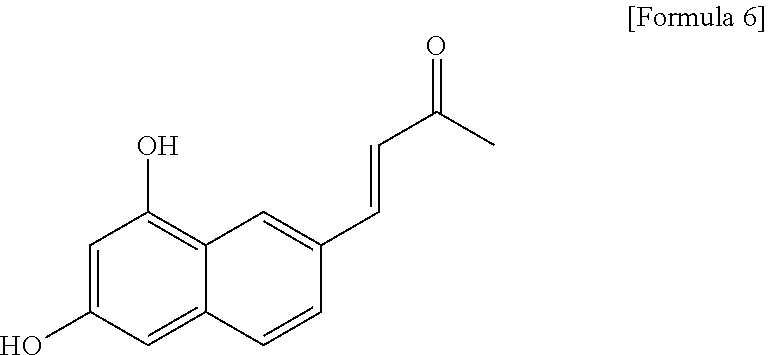
C00019

C00020
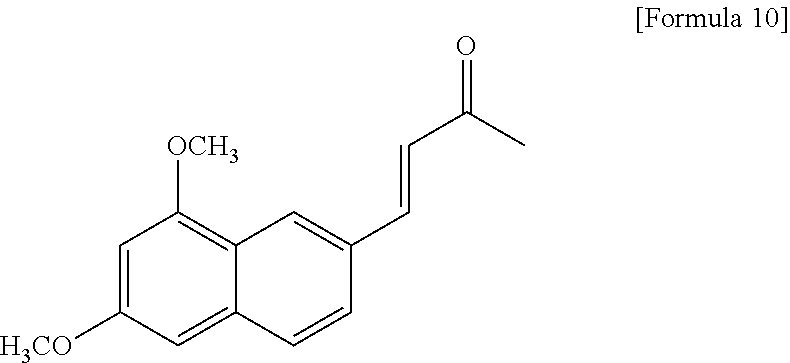
C00021

C00022

C00023

C00024

C00025

C00026
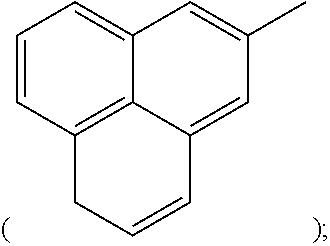
C00027

C00028

C00029

C00030

C00031
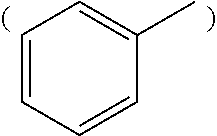
C00032
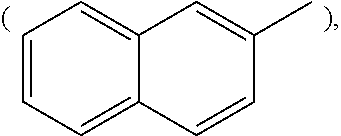
D00001

D00002
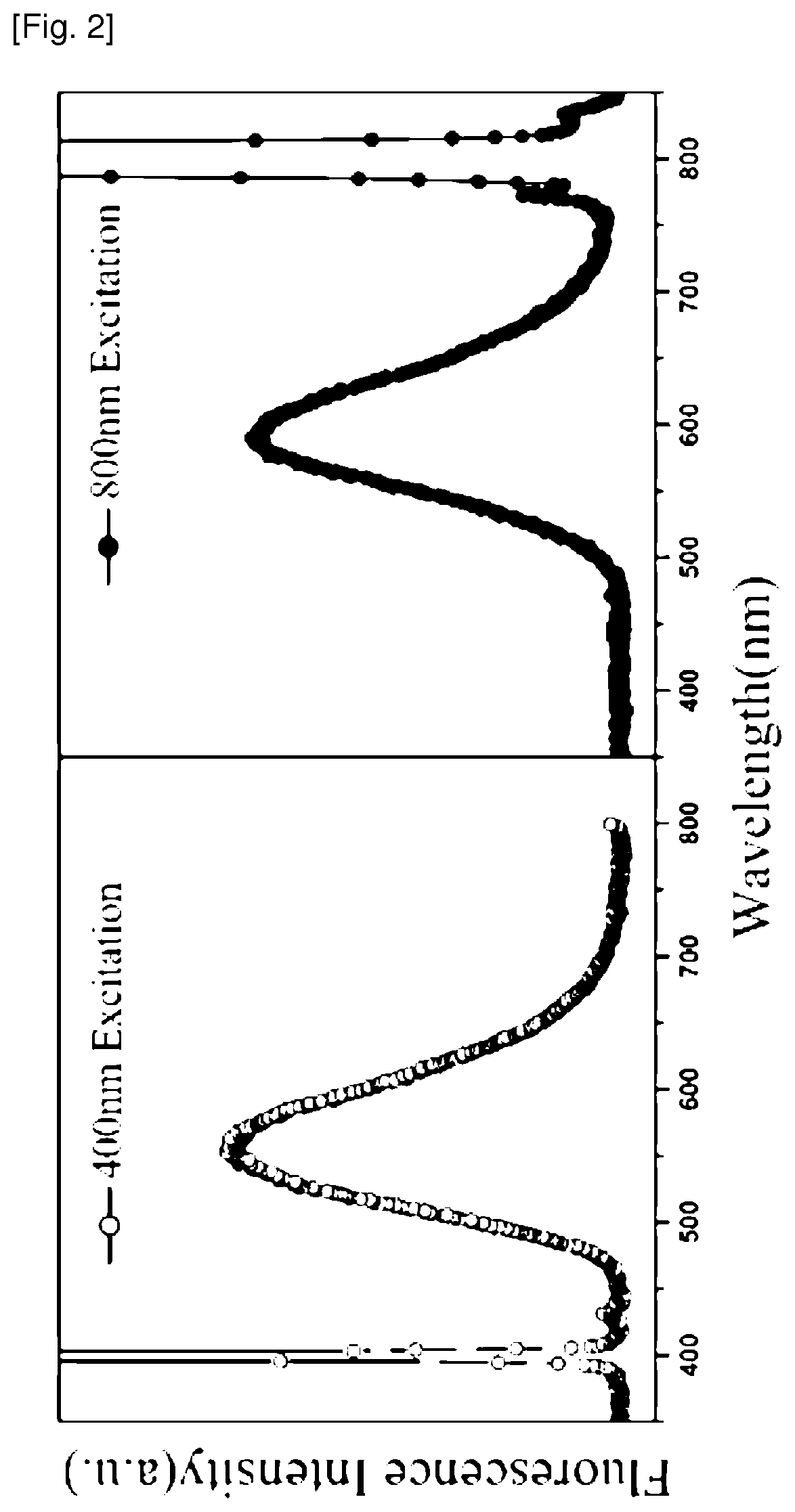
D00003

D00004
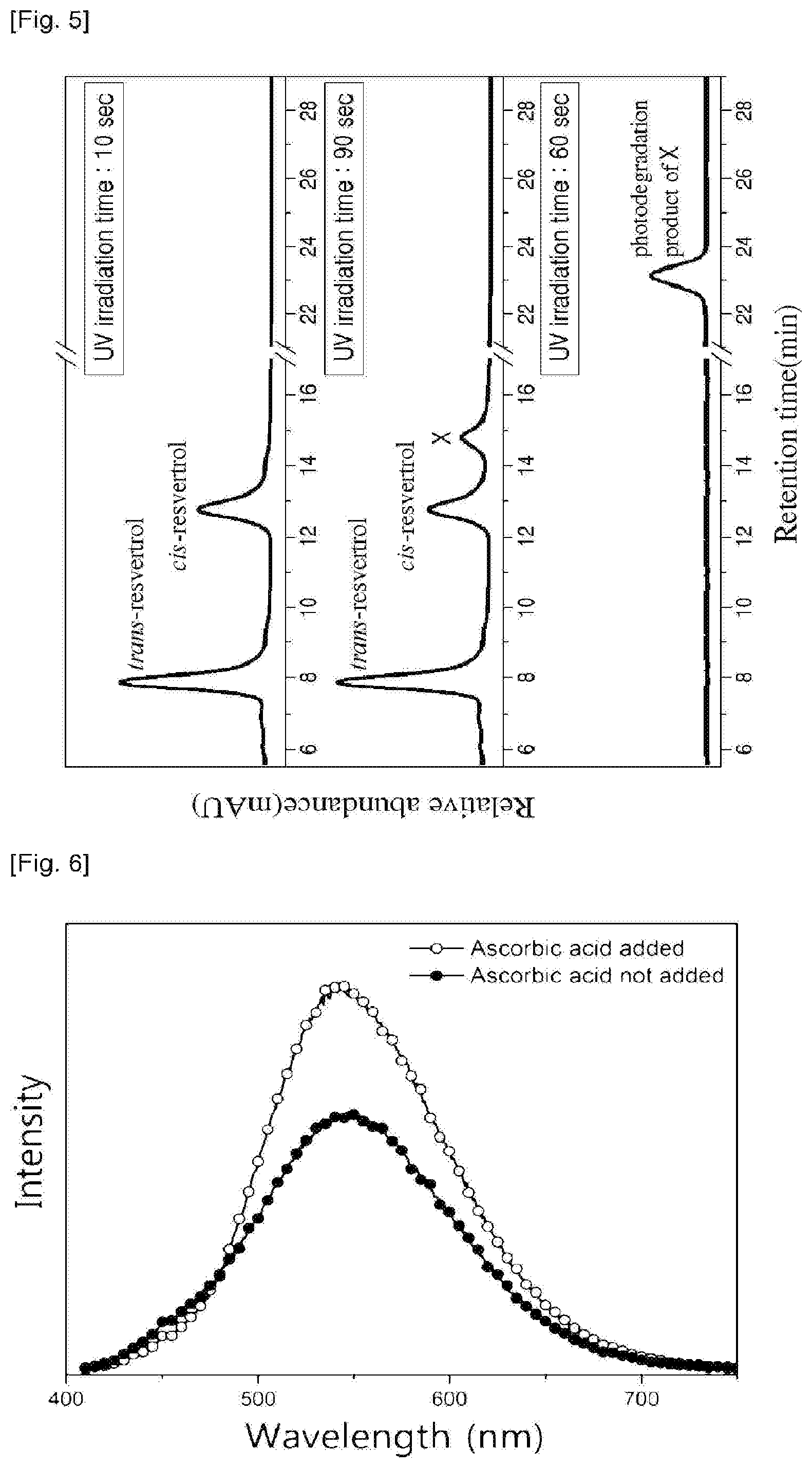
D00005
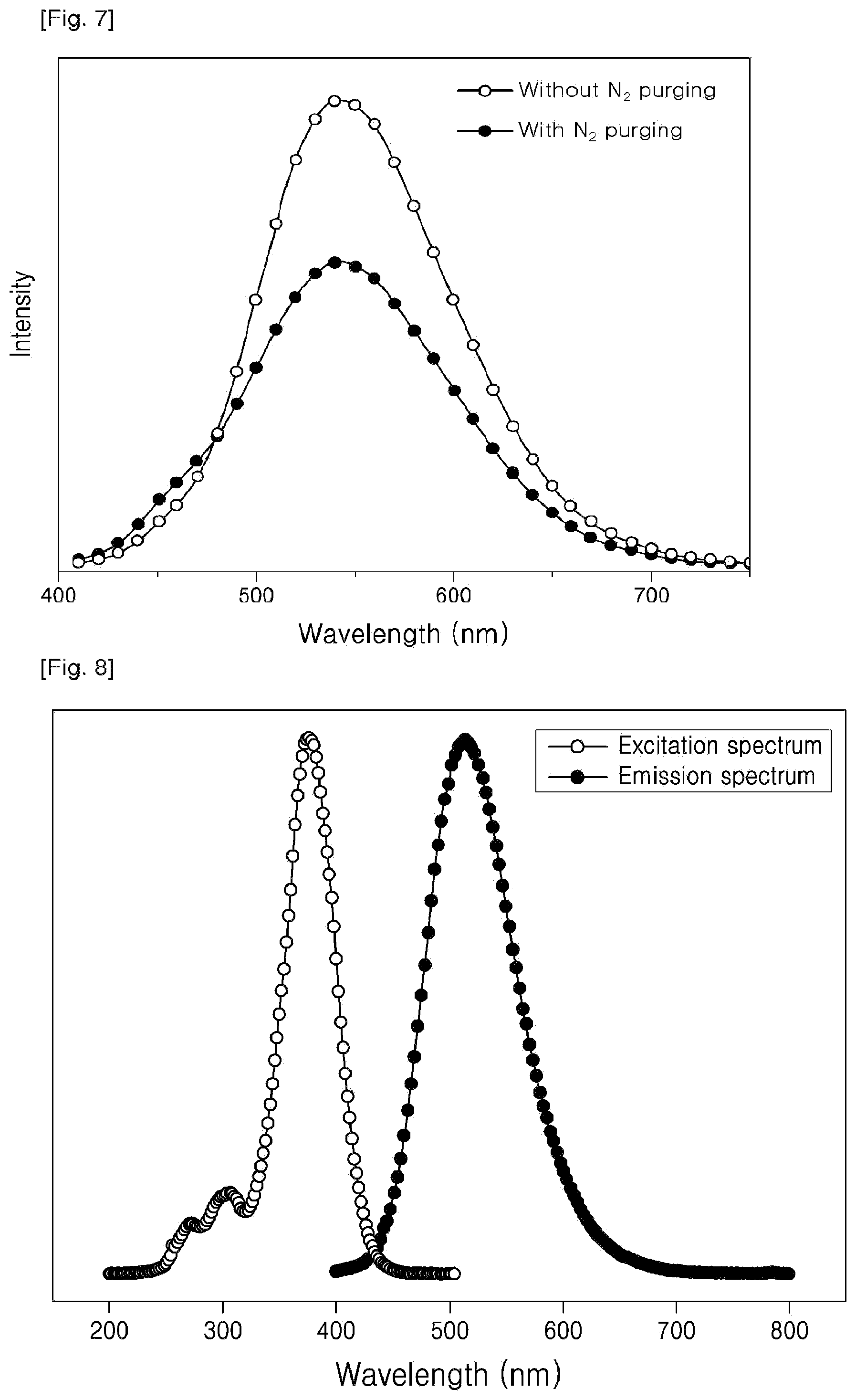
D00006
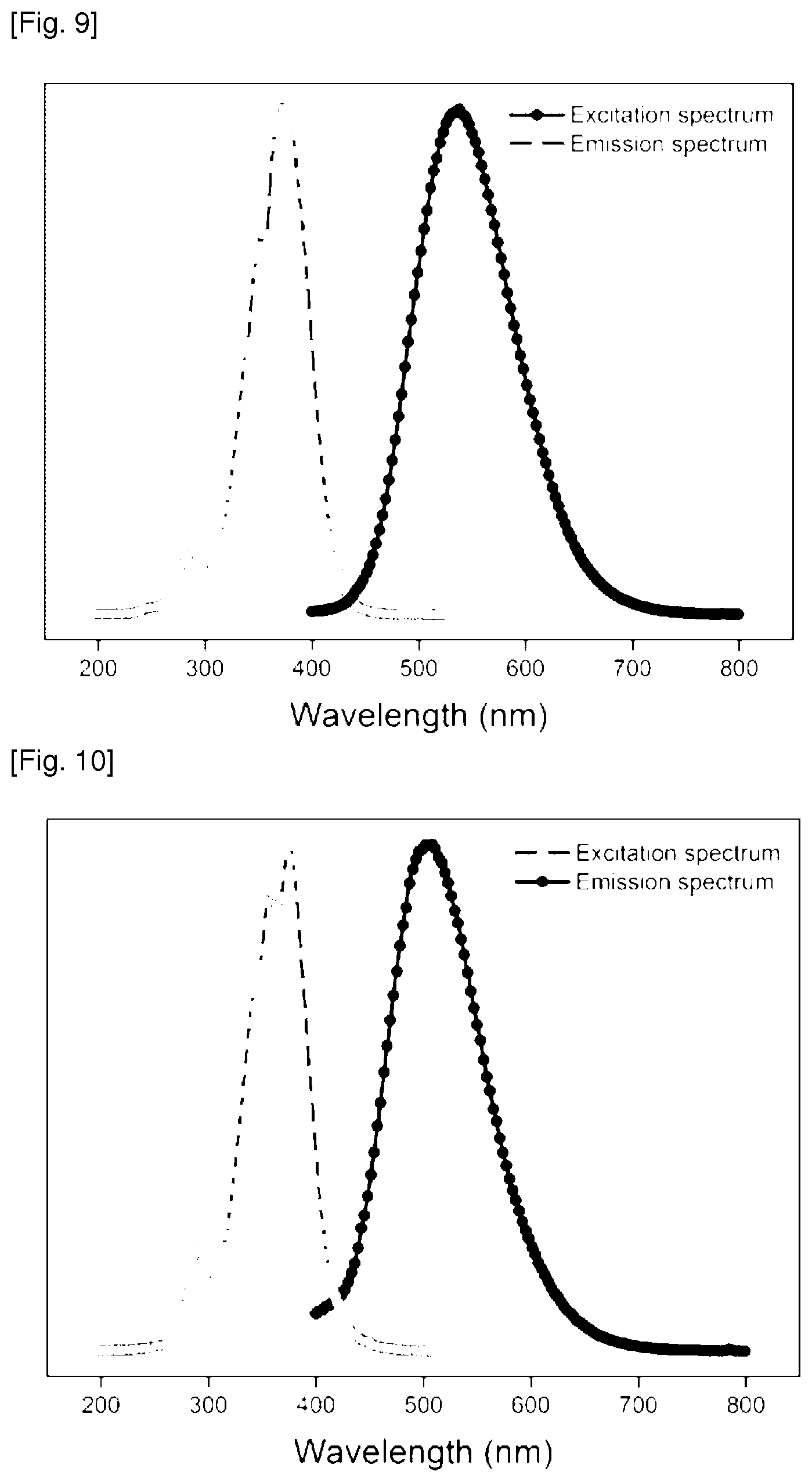
D00007
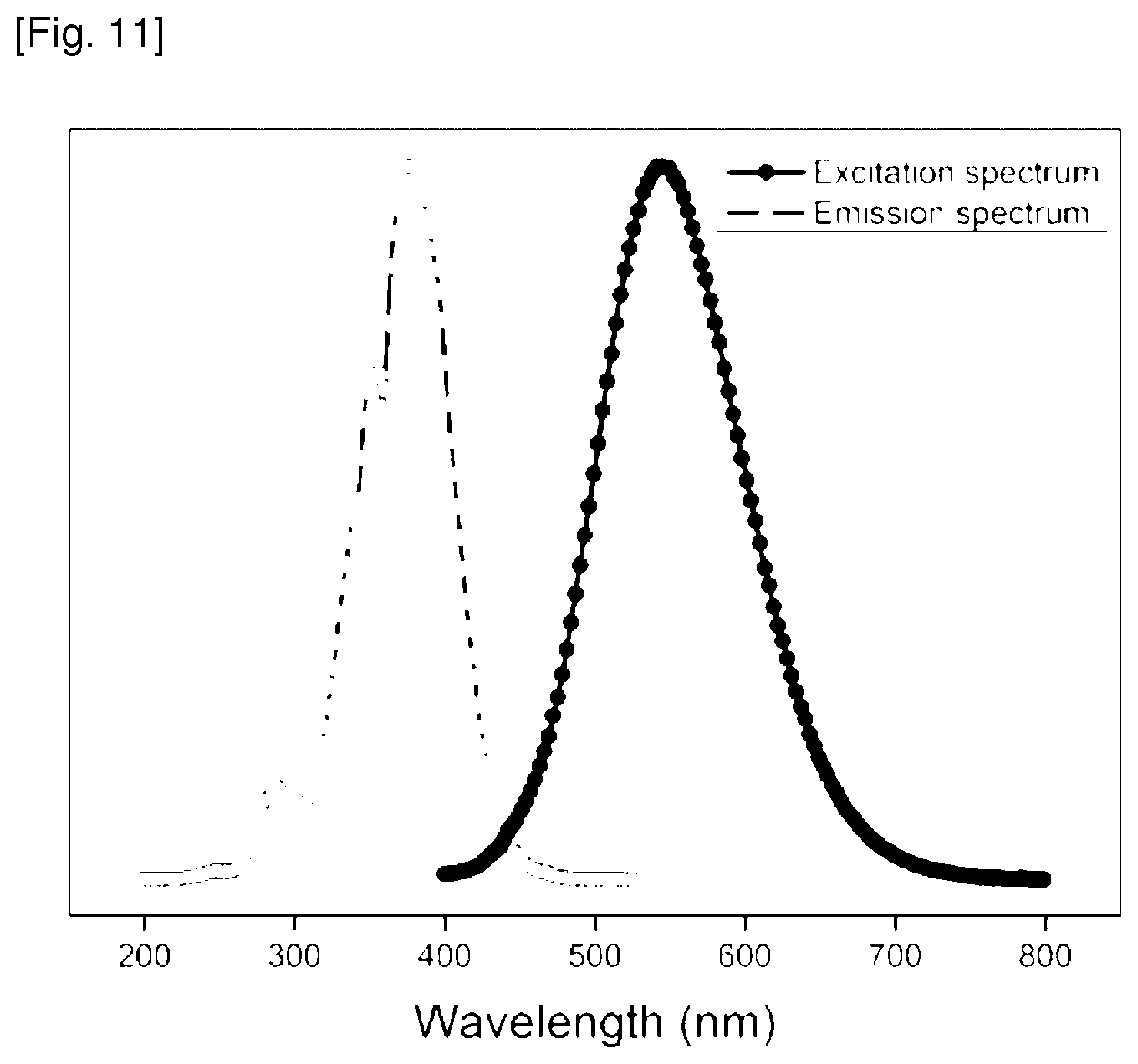
D00008

D00009

D00010

XML
uspto.report is an independent third-party trademark research tool that is not affiliated, endorsed, or sponsored by the United States Patent and Trademark Office (USPTO) or any other governmental organization. The information provided by uspto.report is based on publicly available data at the time of writing and is intended for informational purposes only.
While we strive to provide accurate and up-to-date information, we do not guarantee the accuracy, completeness, reliability, or suitability of the information displayed on this site. The use of this site is at your own risk. Any reliance you place on such information is therefore strictly at your own risk.
All official trademark data, including owner information, should be verified by visiting the official USPTO website at www.uspto.gov. This site is not intended to replace professional legal advice and should not be used as a substitute for consulting with a legal professional who is knowledgeable about trademark law.